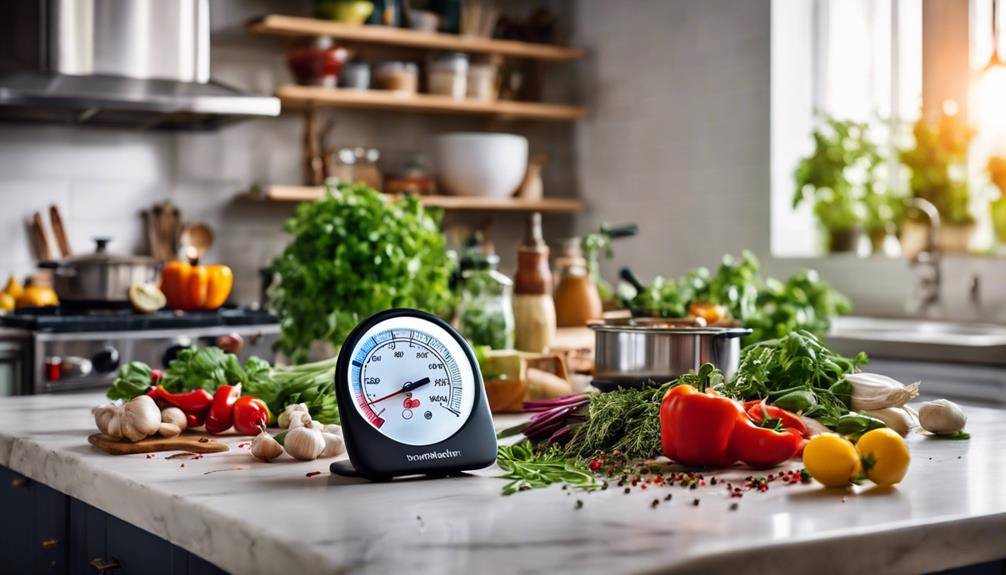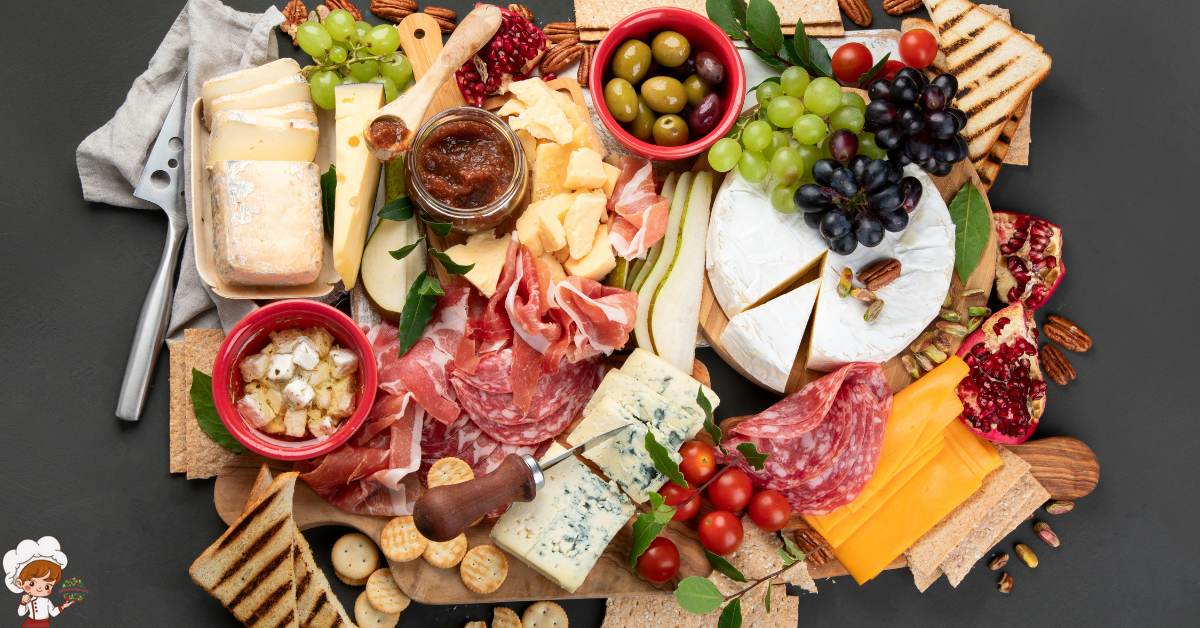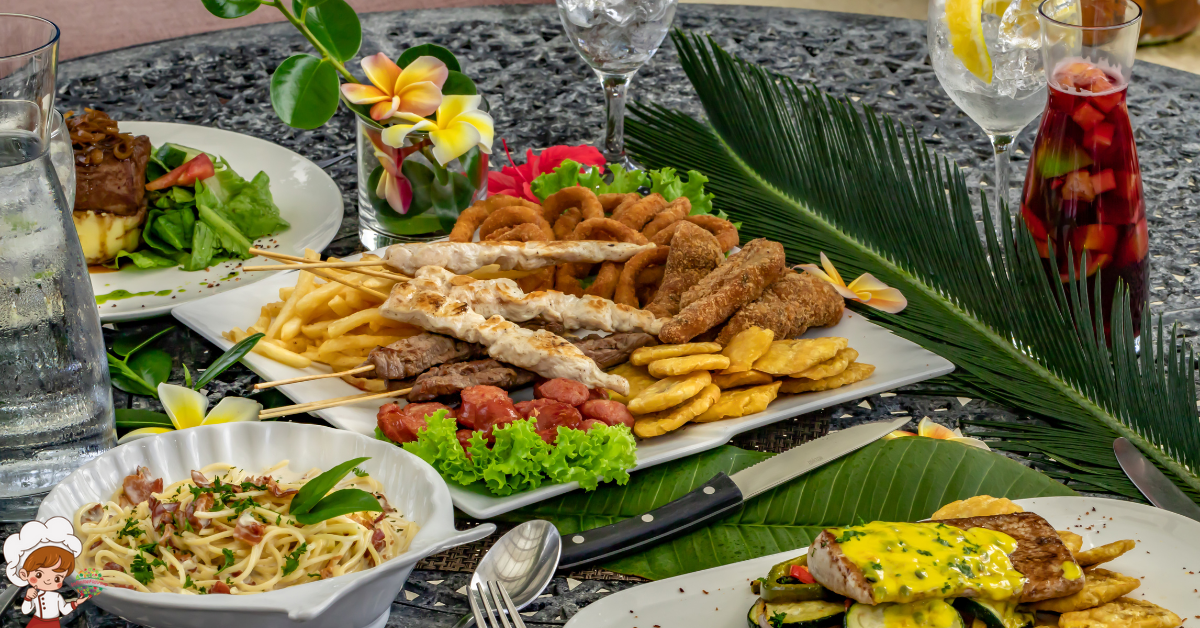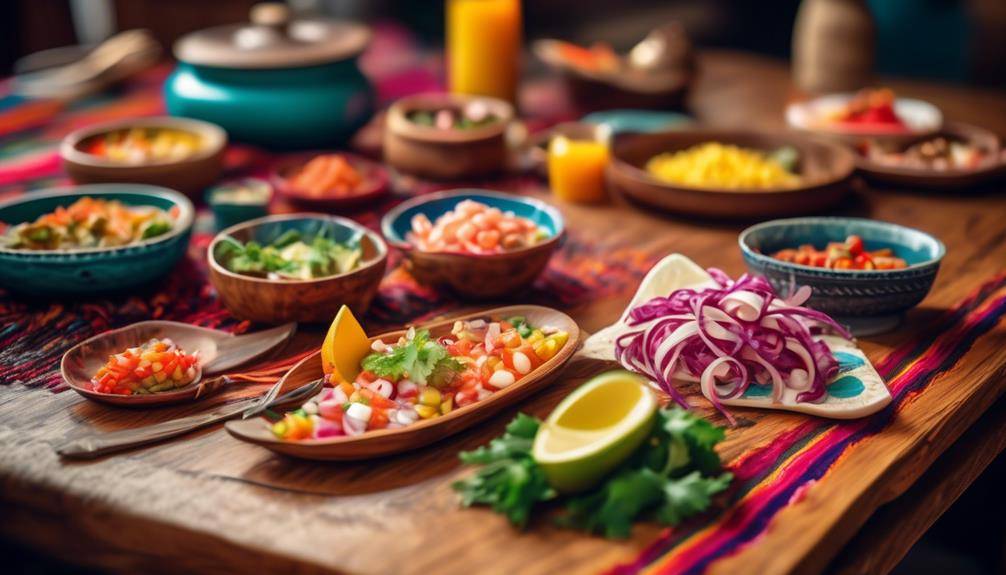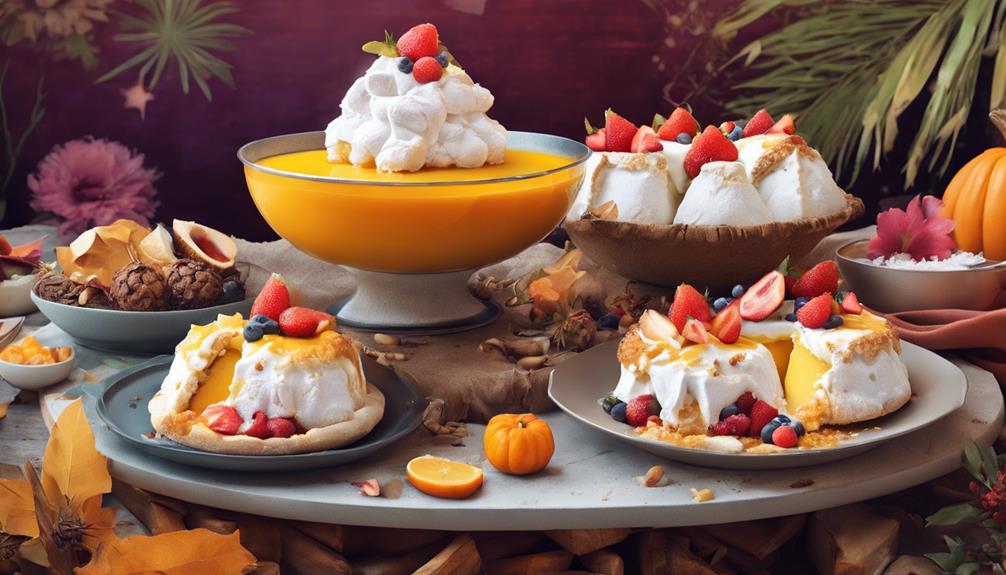Amazing 14 Cast Iron Skillet Recipes From Indian Cuisine
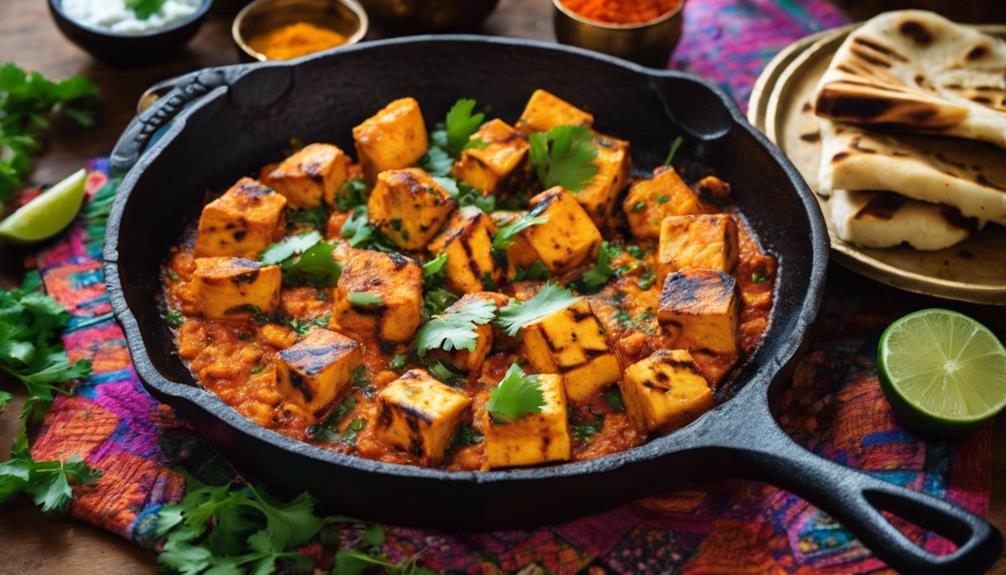
You can elevate your culinary skills with 14 Cast Iron Skillet Recipes From Indian Cuisine. Try flavorful dishes like Vegetable Biryani, where spiced rice meets seasonal veggies, or enjoy the comforting Chana Masala with chickpeas and aromatic spices. If you’re in the mood for something hearty, Aloo Gobi blends potatoes and cauliflower perfectly. Don’t forget to whip up tasty snacks like Paneer Tikka and Samosas, ideal for impressing guests. Each recipe brings authentic flavors to your kitchen. Keep going to discover more about these vibrant dishes and techniques that will wow your family and friends!
Vegetable Biryani
Vegetable biryani is a vibrant and flavorful dish that brings together an array of spices and fresh vegetables in a fragrant rice base. When you’re ready to jump into making this delicious meal, remember that there are numerous biryani variations you can explore. You might choose to include seasonal vegetables like carrots, peas, and bell peppers or even add some chickpeas for an extra protein boost.
To cook the perfect vegetable biryani in your cast iron skillet, start by rinsing the basmati rice until the water runs clear, which helps prevent stickiness. Soak the rice for about 30 minutes before cooking to achieve that fluffy texture. When you heat your skillet, use ghee or oil to sauté your spices—cumin seeds, bay leaves, and cardamom pods—until they release their aromatic flavors. Then toss in your chopped vegetables and stir them for a few minutes.
Once the veggies soften, it’s time to add the soaked rice and water, along with salt to taste. Bring the mixture to a boil, then cover the skillet and lower the heat, allowing it to simmer. One essential cooking tip is to let the biryani rest for about 10 minutes after cooking; this allows the flavors to meld beautifully.
Serve your vegetable biryani hot, garnished with fresh cilantro, and enjoy this delightful dish that’s not only satisfying but also healthy and colorful!
Paneer Tikka
There’s something truly delightful about paneer tikka, a popular Indian appetizer that’s both savory and satisfying. When you think of paneer preparation, this dish often comes to mind. The key lies in marinating the paneer cubes in a mixture of yogurt and spices, allowing them to soak up all those vibrant flavors. You can use spices like garam masala, cumin, and coriander, along with a touch of lemon juice for that zesty kick.
Once your paneer is marinated, it’s time to fire up your cast iron skillet. This cooking method not only gives your paneer tikka a nice char but also helps lock in moisture, keeping your paneer juicy on the inside. You can grill the marinated pieces for about 10-15 minutes, turning them occasionally for even cooking. The result? Perfectly cooked paneer with a smoky flavor that’s hard to resist.
Don’t forget to explore tikka variations! You can add bell peppers, onions, or even mushrooms to your skewers for an extra pop of color and flavor. If you’re feeling adventurous, try experimenting with different marinades, like adding a hint of mint or using spicy chili powder for a kick.
Serve your paneer tikka with mint chutney and sliced onions for a complete experience. Whether you’re hosting a gathering or just craving something delicious, paneer tikka is sure to impress!
Chicken Vindaloo
When you’re in the mood for a dish that packs a punch, chicken vindaloo is the perfect choice. This Goan specialty combines tender chicken with a fiery marinade that’s rich in flavor. The hallmark of vindaloo lies in its spice balance; you’ll find a blend of spices that creates a symphony of heat and depth.
To make your chicken vindaloo, start by marinating chicken pieces in a mixture of vinegar, garlic, ginger, and a robust array of spices like cumin, coriander, and red chili powder. Let it soak up those flavors for at least a couple of hours—overnight is even better! When you’re ready to cook, heat your cast iron skillet and sauté onions until they’re golden brown. Then, add your marinated chicken, allowing it to sear and develop that mouthwatering crust.
It’s worth noting that chicken vindaloo has many regional variations. While the Goan version is known for its fiery kick, other areas may introduce coconut or tamarind for a different flavor profile. Don’t be afraid to experiment with these variations, adjusting the spice levels to suit your taste.
Serve your chicken vindaloo with fluffy basmati rice or warm naan to soak up that rich gravy. You’ll be left with a dish that not only satisfies your craving for bold flavors but also showcases the incredible diversity of Indian cuisine. Enjoy every bite!
Aloo Gobi
Aloo Gobi, a classic Indian dish featuring potatoes and cauliflower, is a delightful choice for those seeking a hearty yet healthy meal. This dish combines the comforting flavors of potatoes with the unique cauliflower texture, creating a satisfying side or main course that’s perfect for any occasion.
To whip up Aloo Gobi in your cast iron skillet, start by heating oil and adding mustard seeds until they pop. Then, toss in chopped onions, garlic, and ginger, sautéing until they turn golden brown. Now, it’s time to add your potato spices—cumin, turmeric, and coriander—making sure they coat the onions beautifully.
Next, add diced potatoes and cauliflower florets to the skillet. Stir everything together, and let them cook for a few minutes. To enhance the flavors, you can add chopped tomatoes and a splash of water, which will help soften the veggies while they absorb the spices. Cover the skillet and let the mixture simmer until the potatoes are tender and the cauliflower is cooked through.
Finish your Aloo Gobi with a sprinkle of garam masala and fresh cilantro. This dish pairs wonderfully with rice or flatbreads, making it a versatile addition to your meal rotation. You’ll love how the potato spices blend seamlessly with the cauliflower texture, creating a dish that’s both comforting and packed with flavor. Enjoy this nutritious delight that’s sure to impress your family and friends!
Masala Dosa
Masala Dosa is a delicious and popular South Indian dish that takes the comforting flavors of Aloo Gobi to a new level. This crispy, golden-brown crepe is made from a fermented batter of rice and split urad dal, giving it a unique texture and flavor. You can easily master the fermentation techniques required for the batter at home, which typically involves soaking the rice and dal overnight, then grinding them into a smooth paste. Let this mixture ferment for about 8 to 12 hours, and you’ll have the perfect base for your dosa.
Once you’ve prepared the batter, you can explore various dosa variations. You could go traditional with a spiced potato filling, mixing boiled potatoes, mustard seeds, turmeric, and green chilies. If you’re feeling adventurous, try stuffing your dosa with sautéed vegetables or even paneer for an extra protein boost.
When it comes to cooking, using a cast iron skillet guarantees that your dosa gets that crispy texture you crave. Heat the skillet well, pour a ladle of batter, and spread it thinly. Drizzle some ghee or oil around the edges for extra flavor and crispiness. Cook until golden, then add your filling and fold it over. Serve your masala dosa hot with coconut chutney and sambar for a delightful meal. This dish not only showcases the versatility of dosa variations but also highlights the importance of fermentation techniques in creating authentic South Indian flavors. Enjoy!
Chana Masala
Chana Masala is a flavorful dish that brings together chickpeas and a mix of spices, making it a staple in Indian cuisine. You’ll want to know the key ingredients and cooking techniques to create this hearty meal in your cast iron skillet. Plus, we’ll explore some delicious serving suggestions that will elevate your dining experience.
Key Ingredients Overview
To whip up a delicious Chana Masala, you’ll need to gather some essential ingredients that bring this dish to life. Start with chickpeas, which are the star of the show, providing protein and a hearty texture. You’ll also want onions, tomatoes, and garlic to create a flavorful base. For the spice essentials, cumin, coriander, turmeric, and garam masala are vital to achieving that authentic flavor profile. Don’t forget fresh cilantro for garnish!
If you’re in a pinch, there are easy ingredient substitutions. Canned chickpeas work just as well as dried ones, saving you time. If you can’t find fresh tomatoes, use canned ones—they’ll still give you that rich taste. While the spices are important, you can adjust them based on your preference. If you’re out of garam masala, a mix of cumin and coriander can serve as a quick alternative.
With these ingredients on hand, you’re well on your way to creating a comforting and flavorful Chana Masala that’s sure to impress. Keep it simple, and don’t hesitate to customize according to your taste!
Cooking Techniques Explained
When cooking Chana Masala, mastering the right techniques can elevate your dish to new heights. Start by using effective sautéing techniques to build a solid flavor base. Heat your cast iron skillet until it’s hot, then add oil and your chopped onions. Sauté them until they’re golden brown, which enhances the sweetness and depth of your dish.
Next, incorporate your spices—like cumin, coriander, and garam masala—right after the onions. This allows the spices to bloom and release their essential oils, infusing the oil with flavor. Once your spices are fragrant, introduce garlic and ginger, allowing them to cook briefly before adding tomatoes.
After combining everything, it’s time for the slow cooking. Add the soaked and drained chickpeas along with water or broth to your skillet. Cover the skillet and let it simmer on low heat. This slow cooking technique allows the flavors to meld beautifully, resulting in a rich and hearty Chana Masala. Stir occasionally to prevent sticking and guarantee an even cook. With these techniques, you’ll create a dish that’s bursting with authentic Indian flavors.
Serving Suggestions Ideas
One of the best ways to enjoy your Chana Masala is by pairing it with warm, fluffy naan or rice. This meal pairing not only complements the rich flavors but also makes for a comforting dish. When it comes to serving styles, consider using a large platter for a family-style meal, allowing guests to help themselves. For a more refined experience, opt for individual bowls, which can enhance the presentation.
To elevate your dish, incorporate some garnishing ideas like fresh cilantro or a sprinkle of pomegranate seeds. These seasonal ingredients add a pop of color and freshness. Alongside your Chana Masala, serve side dishes like cucumber raita or a simple salad to balance the spices.
When considering portion sizes, aim for moderate servings, especially if you’re hosting themed dinners. This way, guests can savor the flavors without feeling overwhelmed. For plating techniques, use a shallow bowl to showcase the Chana Masala’s vibrant colors and textures. Remember to take guest preferences into account, ensuring there’s something for everyone at your table. Enjoy the delightful experience of serving this classic Indian dish!
Egg Curry
Egg curry is a delightful dish that brings together the richness of eggs and a medley of spices, making it a perfect choice for any meal. Whether you’re a novice cook or a seasoned chef, you’ll find that egg preparation is both simple and rewarding. Start by hard-boiling or frying the eggs, depending on your preference. For a classic touch, you can sauté onions, garlic, and ginger in your cast iron skillet, allowing the flavors to develop beautifully.
Once your base is ready, incorporate tomatoes and a selection of spices like turmeric, cumin, and coriander. This is where you can explore different curry variations. Want something creamy? Add coconut milk or yogurt to the mix. Prefer a tangy flavor? A splash of tamarind or lemon juice will do the trick. The beauty of egg curry lies in how you can customize it to suit your taste.
After the spices have blended well, gently add the prepared eggs to the skillet, allowing them to soak in the flavors. Let everything simmer for a few minutes, and don’t forget to garnish with fresh cilantro for that added freshness. Serve your egg curry hot with rice or bread, and enjoy a satisfying meal that’s sure to impress. Whether it’s a weekday dinner or a special occasion, egg curry can easily elevate your dining experience. So, gather your ingredients and get ready to whip up this flavorful dish!
Dal Tadka
After savoring the rich flavors of egg curry, it’s time to explore another classic dish: Dal Tadka. This comforting lentil dish is a staple in Indian kitchens, packed with flavor and nutrition. You’ll love how easy it is to whip up in your cast iron skillet, enhancing the dish with that unique sear.
Dal Tadka typically features toor dal or yellow split peas, but you can experiment with various dal variations like masoor (red lentils) or moong dal. Each type brings its own texture and taste, allowing you to create a unique twist every time. Start by cooking your chosen dal until soft, then prepare the tempering, or “tadka,” which is the heart of this dish. Heat ghee or oil in your skillet, add cumin seeds, garlic, and chopped chilies, and watch as the aromas fill your kitchen.
Once the spices release their fragrance, mix in the cooked dal and season with salt, turmeric, and garam masala. Stir well and let it simmer for a few minutes. The nutritional benefits of Dal Tadka are impressive—it’s high in protein, fiber, and essential vitamins. You’ll not only enjoy a delicious meal but also nourish your body.
Serve it with steamed rice or warm naan for a satisfying feast. Dal Tadka is not just food; it’s a comforting, wholesome dish that brings warmth to any table. Enjoy diving into this culinary delight!
Prawn Curry
Prawn curry is a vibrant and flavorful dish that showcases the succulent sweetness of shrimp paired with a rich, aromatic sauce. To make the perfect prawn curry, you’ll want to choose from various prawn varieties, like tiger, white, or king prawns, each bringing its unique texture and taste to the dish. Start by heating your cast iron skillet and adding oil. Once it’s hot, toss in your chopped onions, sautéing them until they turn golden brown.
Next, add in your curry spices—think turmeric, cumin, coriander, and garam masala. These spices are essential, as they create the aromatic base that elevates the entire dish. Stir in chopped tomatoes and let it simmer, allowing the flavors to meld beautifully. Then, it’s time to introduce the prawns. Cook them until they turn pink and opaque, which usually takes just a few minutes.
For added richness, you can stir in coconut milk or yogurt, which balances the heat of the spices. Finish it off with a squeeze of fresh lime juice and a sprinkle of cilantro to brighten up the flavors. Serve your prawn curry hot with rice or naan, and enjoy the explosion of flavors. This dish not only impresses your guests but also brings a taste of Indian cuisine right into your kitchen. With a few simple ingredients and techniques, you’ll master this delightful prawn curry in no time.
Baida Roti
Baida Roti, a delectable stuffed flatbread, combines the richness of eggs with savory spices and fresh ingredients, making it a popular choice for breakfast or a snack. This dish has its roots in Indian street food, particularly from the regions of Mumbai and Delhi, where it gained popularity in the mid-20th century. Understanding Baida Roti history adds depth to its appeal; it reflects the fusion of flavors and culinary traditions that define Indian cuisine.
When preparing Baida Roti, you’re not limited to one filling. You can experiment with various ingredients, leading to numerous Baida Roti variations. The classic version usually features a mixture of minced meat, onions, and spices, all enveloped in a thin, crispy crust. However, you can easily switch it up by using vegetables, paneer, or even a blend of both for a vegetarian option.
To make it in your cast iron skillet, heat the skillet until it’s hot. Roll out your dough, fill it with your chosen mixture, and cook it until golden brown and crispy on both sides. The skillet’s heat retention guarantees an even cook and a delightful texture.
Whether you enjoy it with chutney, yogurt, or simply on its own, Baida Roti will surely impress your taste buds. So next time you’re craving something savory, give this versatile flatbread a try!
Spinach and Cheese Flatbread
While you’re looking for a delicious and nutritious option, Spinach and Cheese Flatbread is a fantastic choice that combines the earthy flavor of spinach with the creamy richness of cheese. This dish not only satisfies your cravings but also packs a punch of vitamins and minerals. You can easily whip it up in a cast iron skillet, allowing for even cooking and a perfect crispiness.
Start by preparing your dough, which can be a simple mix of flour, water, and a pinch of salt. While it rests, sauté fresh spinach in olive oil until wilted. Next, choose your cheese types—feta, mozzarella, or paneer work wonderfully. Crumble or shred your cheese and combine it with the spinach, adding spices like cumin or chili flakes for an extra kick.
Roll out your dough into flatbread variations, depending on your preference for thickness. Heat your cast iron skillet, and place the rolled dough inside. Spoon the spinach and cheese mixture onto half of the flatbread, then fold it over and press the edges to seal. Cook until golden brown on both sides, ensuring the cheese melts and the spinach is warm.
Serve your Spinach and Cheese Flatbread hot, perhaps with a side of yogurt or a tangy chutney. This dish is perfect for lunch or a light dinner, and it’s a surefire way to impress your family and friends with your cooking skills! Enjoy this delightful flatbread variation as part of your Indian cuisine repertoire.
Samosa
After enjoying the delightful Spinach and Cheese Flatbread, it’s time to explore another beloved Indian snack: the Samosa. You might be surprised to learn that the samosa has a rich history, tracing back to the Middle Ages. Originally known as “sambusak,” it was brought to the Indian subcontinent by traders and travelers. Over time, this crispy pastry evolved to reflect regional tastes and ingredients, creating a world of samosa variations.
When you think of a classic samosa, you likely envision a triangular, golden-brown pastry filled with spiced potatoes, peas, and sometimes meat. But the beauty of the samosa lies in its versatility. You can experiment with a variety of fillings, like lentils, paneer, or even sweet options filled with coconut and jaggery. Each region in India boasts its own take on the samosa, whether it’s the spicy, onion-filled versions from North India or the unique potato and spice-filled varieties found in South India.
Making samosas in a cast iron skillet elevates their crunchiness while providing a beautiful golden color. You can easily fry them or bake them for a healthier option. So gather your ingredients, and embrace the creativity that comes with crafting samosas. Whether you’re sharing them at a gathering or enjoying them solo, these delectable snacks will surely impress. Now that you’ve got the basics down, it’s time to plunge into the fun of making your own samosas!
Lamb Kofta
When you make lamb kofta, you’ll experience a flavorful spice blend that elevates this dish to new heights. Understanding the right cooking techniques is essential for achieving that perfect balance of juiciness and crispness. Let’s explore how to master this delicious recipe in your cast iron skillet.
Flavorful Spice Blend
A flavorful spice blend is essential for crafting delicious lamb kofta that bursts with Mediterranean flair. To elevate your kofta, you’ll want to combine key spices that not only enhance flavor but also guarantee spice preservation. Start with a mix of ground cumin, coriander, and paprika for that warm, earthy base. These spices not only complement the lamb but also help maintain freshness longer when stored properly.
Add a pinch of cinnamon for a hint of sweetness and depth. Don’t forget fresh herbs like parsley and mint; they bring a vibrant freshness that brightens the dish. A sprinkle of cayenne pepper or chili flakes can introduce a subtle heat, balancing the richness of the lamb.
When mixing your spices, consider toasting them lightly in your cast iron skillet to release their essential oils, amplifying their flavor enhancement capabilities. This simple step can make a world of difference. Once you’ve blended the spices, incorporate them into your lamb mixture, assuring each bite is infused with that irresistible Mediterranean essence. With the right blend, your lamb kofta will be a standout dish everyone will love.
Cooking Techniques Overview
Mastering cooking techniques for lamb kofta can elevate your dish from good to unforgettable. Start by exploring various cooking styles, such as grilling or pan-frying in your cast iron skillet. Both methods offer unique flavor enhancement, but the choice depends on your preference and available tools.
Heat control is vital; maintain a medium-high temperature to achieve that desirable crust while ensuring the inside stays juicy. When it comes to meal prep, mix your meat with spices and allow it to marinate for a few hours. This brings out the spices’ full potential and enhances the overall flavor.
Ingredient pairing is essential, too. Serve your kofta with cooling yogurt sauce or tangy chutneys for a delightful contrast. Texture contrast plays a significant role in creating a memorable dish, so consider adding crispy vegetables or flatbreads alongside your kofta.
Lastly, don’t underestimate the power of seasoning techniques. A sprinkle of salt or a touch of acidity can brighten the flavors. By incorporating these traditional methods and mindful techniques, you’ll craft lamb kofta that’s not just a meal but an experience to savor.
Coconut Rice
Coconut rice is a delightful twist on the traditional grain that’s sure to elevate any meal. This dish combines the fragrant essence of coconut with fluffy rice, creating a perfect side that complements various Indian dishes. You’ll love how easy it is to prepare and how it adds a tropical flair to your table.
Using a cast iron skillet enhances the flavor and texture of your coconut rice. Start by toasting the rice in your skillet until it’s slightly golden, which brings out a nutty aroma. Then, add coconut milk, a splash of water, and a pinch of salt. As it cooks, the coconut milk infuses the rice with a creamy richness, providing numerous coconut benefits, such as healthy fats and antimicrobial properties.
Feel free to explore different rice variations, like jasmine or basmati, to suit your preference. You can also add a few spices like cardamom or cumin to enhance the flavor profile. For a bit of crunch, toss in some toasted nuts or fried onions before serving.
Coconut rice pairs beautifully with curries, grilled meats, or even as a standalone dish. It’s not just a side but a delightful centerpiece that showcases the versatility of rice in Indian cuisine. So, next time you’re looking to impress your guests, whip up some coconut rice in your cast iron skillet and watch them savor every bite!
Cast Iron Skillet Recipes From Indian Cuisine; Frequently Asked Questions
Can I Use a Non-Stick Skillet for These Recipes?
You can use a non-stick skillet for these recipes, but it lacks the heat retention of cast iron. Non-stick advantages include easier cleanup, but skillet comparisons show cast iron often enhances flavors better.
What’s the Best Way to Clean My Cast Iron Skillet?
To clean your cast iron skillet, scrub it with a brush and hot water. Avoid soap; it can strip seasoning. Regular skillet care enhances its benefits, ensuring a non-stick surface that improves over time.
How Do I Season My Cast Iron Skillet?
To season your cast iron skillet, start by cleaning it thoroughly. Then, apply a thin layer of oil and bake it upside down at high heat. This enhances cast iron benefits and improves seasoning techniques.
Can I Substitute Ingredients in These Recipes?
Yes, you can substitute ingredients in these recipes. Just remember to contemplate ingredient alternatives that maintain the dish’s essence. You might need to make flavor adjustments to achieve the desired taste and texture.
What Temperature Should I Preheat My Skillet Before Cooking?
You should preheat your skillet to medium-high heat for even cooking. Proper skillet heating enhances flavors and guarantees your cooking techniques yield the best results, so don’t rush this essential step in your preparation.
Conclusion
Now that you’ve explored these delicious cast iron skillet recipes from Indian cuisine, it’s time to fire up your skillet and get cooking! Each dish offers a unique blend of spices and flavors that’ll transport you straight to India. Whether you’re craving hearty biryani or crispy dosas, these recipes are sure to impress. So gather your ingredients, invite some friends over, and enjoy the vibrant tastes of India right in your kitchen. Happy cooking!



